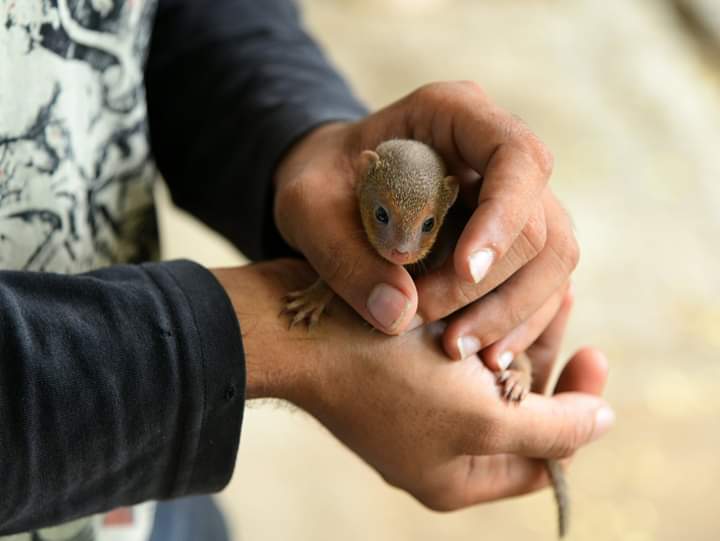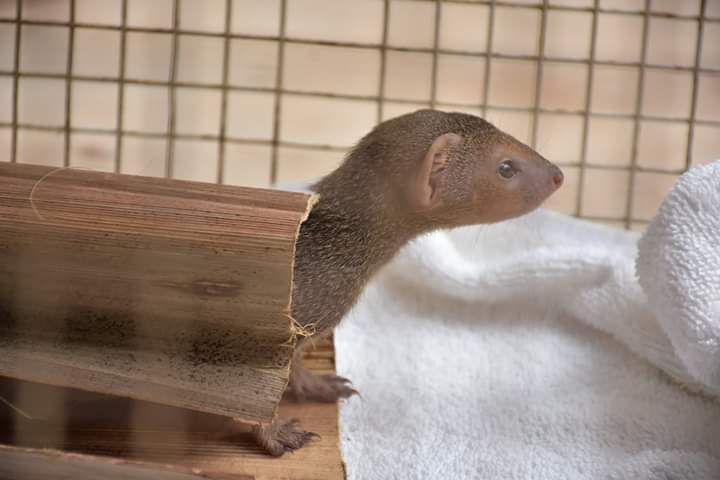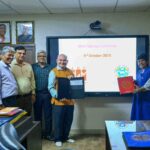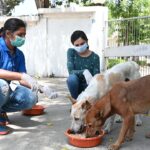Mongose Baby Rescued and Rehabilitated

The Indian Grey Mongoose is ubiquitous in India. It is often found near human settlements in villages as well as cities where it survives primarily on scavenging leftovers or preying upon rodents. It lives in closed spaces like bushes or drains. In fact, it is one of the easily recognized animals and even children can recognize it. The Hindi name for it is ‘nevla’. Although it may look adorable, especially when young, it can pack quite a punch when it feels threatened. It has a vicious bite and sharp claws too.
What sets this amazing creature apart is its ability to take on venomous snake. It is naturally a bold animal. Its thick fur and body’s unique metabolism make it resistant or even immune to the venom of snakes which would otherwise be lethal to any other animal. It possesses quick reflexes which make it difficult for a snake to bite it. The snake tires out and is pounced upon by the acrobatic mongoose which administers a lethal bite to its neck or head. But this is not it. It has been seen to take on even scorpions and is unaffected by the venom. It makes no attempt to remove the sting and simply devours it.
The mongoose has a vivid diet which includes rodents, birds, insects and basically any creature it can overpower and consume. Unfortunately, the thick and coarse fur coat of this incredible animal is illegally used for making shaving and painting brushes. This is the biggest threat to it. Several hundred kilos of its fur have been seized by the authorities. The mongoose is a protected species and harming or killing it is a punishable offence by law.
The mongoose plays a vital role in the ecology it lives in. In the cities, it hunts rodents and keeps their population in check. However, it is very rare to spot a mongoose in urban areas as they stay hidden in closed areas. They seldom venture too far from their dwelling. The audacious ‘nevla’ also guards human settlements against snakes. It is for this reason that some people keep mongoose as a pet, particularly in rural parts of the country.

As is the case with all mammals, mongoose babies are helpless at birth and need their mother to look after them. They depend upon their mother for food and protection from other animal threats to their survival. They also learn hunting by observing their mother and stay with her till they become capable of living on their own.
JCT came across a cute but vulnerable mongoose baby that needed immediate intervention to survive.
This tiny, frail looking baby was found by a taxi driver. The kind-hearted gentleman found this poor thing in an abandoned parking lot. It was piteously calling out for its family. It was separated from others and was clueless. Without help, it would soon perish from hunger and thirst. If not, stray dogs would have made a meal out of it. The man looked for other mongooses in the vicinity so as to reunite the poor thing with its mother. However, he had no success. He did the right thing to bring the little one to our animal centre where it could be nourished, and further course of action would be planned.
It was estimated by our veterinary doctors that it was barely a couple of weeks old. It underwent an examination by the vets who recommended round the clock care in the initial few days till it acclimatized to the new surroundings. This was a huge responsibility as it required timely feeding and keeping an eye on it. This task was promptly taken on by the staff who fed it at regular hours throughout the day and even night. However, there was a tricky and delicate thing that had to be kept in mind during its stay. It had to be made sure that the tiny one doesn’t get too used to human interaction. This was because though they live near humans, mongooses do not directly come in contact with people. They maintain a safe distance from them. The baby had to be prevented from getting accustomed to human touch or else it would become dependent for a lifetime on help from people.
The diligent care and ceaseless efforts soon bore fruit. In two months, it had grown to become a wonderful and robust adult mongoose. It was time to give it a taste of the independent life. After a wild animal, brought in for treatment, recovers from its injury, it is first given a ‘soft release’ before being released to its habitat. This is a necessary step as the handlers can see if it can cope up on its own. Also, it gives the animal an exposure so that the release does not come as a shock. The mongoose was put in an enclosure outside. After the vets deemed it fit for an independent life, the handlers took it to the place it was found in. We hope it has a healthy natural life.
Every day, JCT comes across animals that need help and care without which they would surely perish. This needs experienced vets and appropriate medications. But the job doesn’t end here. While they recover, they need expert and compassionate handlers who feed them timely and be watchful. All this, from medicines to human help, requires an impeccable management of human and financial resources. It is not possible for all to be on the ground, but you can still lend a helping hand by making a generous donation. This will go a long way in our cause to help every mute soul.
Remember that this land is not the property of human beings alone. Flora and fauna have inhabited what we call our homes since long before we settled. We are dependent on our environment and any imbalance in nature will have a domino effect on our survival too.







